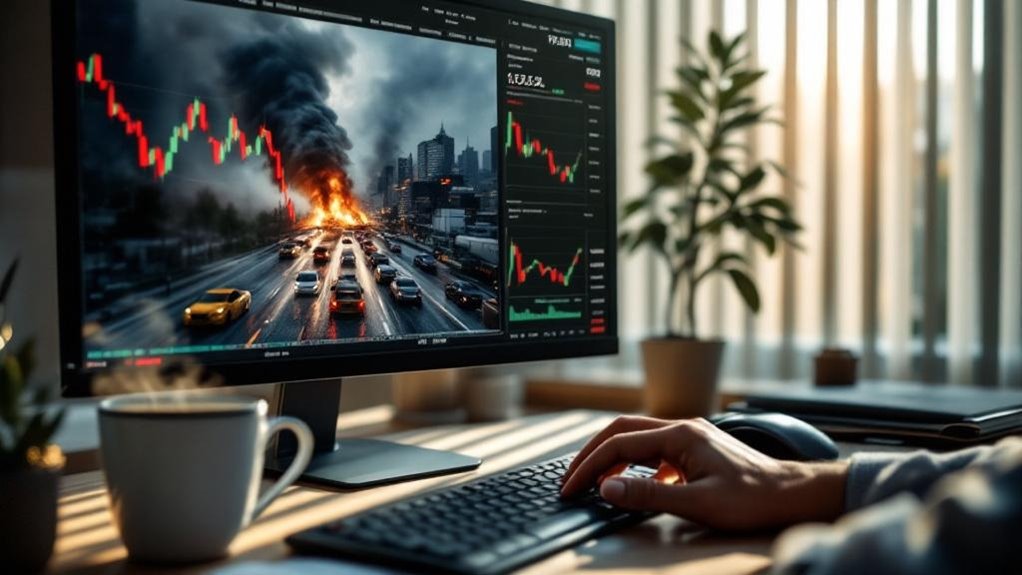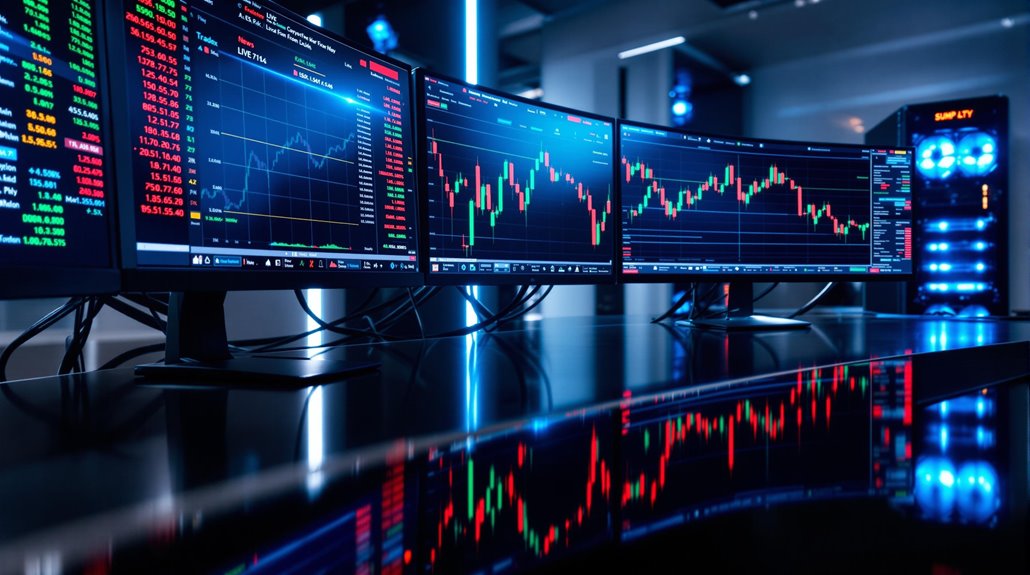News-based trading capitalizes on market-moving events through systematic analysis of economic data releases, central bank decisions, and geopolitical developments to identify profitable opportunities. Professional traders employ specialized strategies like the slingshot approach and fade technique, while utilizing real-time news aggregators and volatility-adjusted stop-loss protocols to manage risk exposure during high-impact announcements. Mastering the psychological and technical aspects of event-driven trading reveals substantial profit potential in today’s data-driven markets.
Key Takeaways
- Monitor high-impact economic releases, central bank decisions, and corporate earnings announcements to identify potential market-moving events.
- Implement slingshot or fade strategies to capitalize on market overreactions following significant news events.
- Use real-time news aggregation platforms and economic calendars to maintain situational awareness and anticipate market movements.
- Set volatility-adjusted stop-losses between 1-3x ATR and limit event-driven exposure to 0.5-1% of total capital.
- Integrate technical analysis with news events to confirm trade signals and validate entry points for better timing.
Understanding Market-Moving Events

While financial markets respond to countless variables on a daily basis, certain market-moving events consistently generate substantial price action and volatility across asset classes.
Economic data releases, particularly employment figures, inflation metrics, and GDP reports, serve as critical market indicators that can trigger immediate price adjustments when deviating from consensus expectations. Savvy investors regularly consult the economic calendar to anticipate and prepare for these market-moving releases.
The regular news cycles surrounding central bank decisions and monetary policy statements frequently catalyze significant market movements, especially during interest rate announcements and forward guidance updates. Understanding duration management strategies becomes crucial when navigating interest rate-driven market environments.
Geopolitical developments and corporate earnings releases represent additional pivotal events that shape market trajectories.
These catalysts often manifest through sector rotations, currency fluctuations, and broad market sentiment shifts. Major political decisions, international conflicts, and unexpected corporate performance metrics can establish new market trends or reverse existing ones, making the monitoring of these events essential for implementing effective trading strategies.
Key Strategies for News Trading Success
As financial markets rapidly process and react to news events, successful news-based trading requires implementing specific, well-defined strategies that capitalize on predictable market behaviors and price movements.
Two primary approaches stand out for their effectiveness in news-based trading: the slingshot strategy and fade strategy. The slingshot strategy positions traders to profit from market overreactions by taking contrary positions after initial price movements, while the fade strategy specifically targets short-term reversals following news-driven spikes.
Given that less than 3% of day traders achieve profitability in the markets, mastering these specific news-based approaches becomes even more critical for success.
Successful implementation of these strategies demands:
Strategic success in news trading hinges on precise execution, disciplined timing, and unwavering commitment to proven methodologies.
- Precise timing of entry points
- Rapid assessment of market sentiment
- Clear stop-loss parameters
- Integration of technical analysis
- Continuous monitoring of price action
Traders must complement these approaches with thorough economic calendar preparation and post-news analysis to optimize their execution.
This systematic framework enables traders to navigate news-driven volatility while maintaining disciplined risk management protocols.
Implementing strict position sizing across different asset classes helps protect against excessive losses while maximizing potential opportunities in news-driven markets.
Risk Management During High Volatility

During periods of heightened market volatility surrounding news events, implementing precise stop-loss placement and calculated position sizing becomes paramount for effective risk control.
Traders must establish volatility-adjusted stop-loss levels that account for potential price gaps and extreme market reactions, typically setting these protective barriers at technical support/resistance points beyond normal price fluctuation ranges. Successful traders know that planning ahead helps maintain discipline and prevents emotional decision-making during volatile news-driven markets. Understanding implied volatility patterns during earnings season can help traders better anticipate and prepare for potential market swings.
Position sizing should be reduced proportionally to anticipated volatility spikes, with many professional traders limiting event-driven exposure to 0.5-1% of total capital to protect against outsized losses during news-induced market turbulence.
Volatility Stop-Loss Placement
Because news-driven market volatility demands sophisticated risk management protocols, traders must implement robust stop-loss strategies that adapt to rapidly changing market conditions. Effective volatility adjustments require systematic implementation of ATR-based methodologies, with stop placement typically ranging from 1x to 3x ATR multiples. The Chandelier Exit method provides an additional tool for maintaining positions during strong trends while automatically adjusting stops based on volatility levels. Volume price divergence signals can help validate stop placement decisions during volatile market conditions.
| Volatility Level | ATR Multiple | Position Size Adjustment |
|---|---|---|
| Low | 1x-1.5x | Standard |
| Medium | 1.5x-2x | Reduce 25% |
| High | 2x-3x | Reduce 50% |
During high-impact news events, traders employ wider stop distances calibrated to current market conditions while maintaining consistent risk parameters through position size modifications. The integration of technical support/resistance levels with ATR-based stops provides a thorough framework for risk management, allowing traders to navigate volatile market conditions while preserving capital.
Pre-Event Position Sizing
Strategic position sizing represents a foundational pillar of risk management when trading around high-impact news events. Pre-event analysis must incorporate both fixed percentage allocations and volatility-based adjustments to optimize risk exposure.
Implementing a systematic approach to position sizing requires careful consideration of multiple risk factors. Traders typically limit exposure to 1-2% of account capital per trade while making position adjustments based on implied volatility surges before major announcements. A proper risk-reward ratio of at least 2:1 should be maintained even during news-driven volatility.
Maximum capital allocation limits, often capped at 5% per position, help prevent overconcentration during volatile periods. To maintain portfolio stability, traders must also monitor correlation risk across concurrent positions. Using technical confirmation signals from multiple timeframes can help validate position sizing decisions before major news events.
Real-time tracking of aggregate exposure relative to account equity guarantees systematic risk control, particularly when multiple assets face simultaneous event risk.
Essential Tools for Event-Driven Trading
Real-time news aggregation platforms serve as foundational instruments for event-driven trading strategies, enabling traders to efficiently monitor and analyze market-moving developments across multiple financial information sources simultaneously.
Economic calendar management tools integrate seamlessly with these aggregators, providing structured oversight of scheduled market events including earnings releases, Federal Reserve announcements, and key economic indicators. Monitoring consumer confidence indices helps traders anticipate potential shifts in market sentiment and economic cycles.
The synchronization of these essential tools allows traders to maintain thorough situational awareness while executing time-sensitive trading decisions based on emerging market catalysts. Advanced platforms with algorithmic trading capabilities help automate trade execution according to predefined event parameters.
Real-Time News Aggregators
Modern news aggregation platforms serve as indispensable tools for event-driven traders, consolidating vast amounts of market-relevant information from diverse global sources into streamlined, actionable intelligence.
These sophisticated systems deliver real-time updates through AI-powered filtering and analysis, processing over 1.8 million market events monthly across multiple asset classes. Platforms like LevelFields and Stock Titan integrate news from thousands of sources while employing advanced sentiment analysis and event detection algorithms. Investors can access customizable trading strategies through these platforms, with some offering over 100 different approaches to market analysis.
Understanding market sentiment indicators helps traders identify potential turning points where crowd psychology shifts between fear and greed.
Customizable filters enable traders to sort information by sector, market cap, or price movements, while automated categorization systems tag content for enhanced relevance.
Through specialized feeds focusing on specific asset classes and immediate flash alerts, these platforms provide traders with the extensive market coverage and rapid information delivery essential for maintaining a competitive edge in today’s fast-moving markets.
Economic Calendar Management
Professional event-driven traders depend heavily on extensive economic calendar management systems to navigate the complex landscape of market-moving releases and announcements that shape global financial markets.
Traders can analyze over 300,000 economic indicators from more than 190 countries to make informed trading decisions.
These sophisticated platforms facilitate thorough economic calendar synchronization across multiple time zones while enabling precise event impact assessment through advanced filtering and categorization features.
Modern calendar management tools integrate seamlessly with trading platforms and analytical systems, providing traders with automated notifications, historical data analysis, and real-time updates.
The platforms incorporate risk management protocols, including pre-event preparation tools for setting appropriate position sizes and stop-loss levels based on anticipated volatility.
Sector rotation patterns provide crucial insights for timing market entries and exits across different industry groups during various economic cycles.
Through API connectivity and AI-powered analytics, these systems enable traders to maintain a thorough view of market-moving events while coordinating their trading strategies across multiple asset classes and time zones.
Psychological Aspects of News Trading

The intricate interplay between human psychology and financial markets stands at the core of news-based trading, where emotional responses and cognitive biases greatly influence trading decisions and outcomes. Developing emotional resilience and cognitive awareness becomes vital for traders maneuvering through the psychological challenges of news-driven market movements.
Market participants must contend with powerful psychological forces, including fear, greed, and loss aversion, which can greatly impact trading performance during volatile news events. Research shows that missing the best days in market trading can result in millions in lost potential earnings over time. The combination of time pressure and crowd behavior often amplifies these psychological effects, leading to potentially irrational decision-making.
To combat these challenges, successful traders implement structured routines and systematic approaches that minimize the impact of cognitive biases. This includes maintaining strict risk management protocols, analyzing sentiment indicators objectively, and regularly reviewing trading decisions to identify psychological patterns that may impair judgment during news-based trading operations. Historical evidence suggests that even Peter Lynch’s approach favored disciplined investing over attempting to time market movements based on news events.
Advanced Event Analysis Techniques
While psychological factors shape trading behavior, sophisticated event analysis techniques form the analytical foundation of successful news-based trading operations.
Modern trading platforms integrate advanced event classification systems that categorize market-moving developments into anticipated and unanticipated events, enabling precise response protocols. The systems often incorporate technical indicators to validate trading signals generated from news events.
Quantitative models leverage sentiment analysis and machine learning algorithms to process vast amounts of unstructured data, identifying actionable trading signals within milliseconds.
Statistical frameworks measure abnormal returns during specific event windows while correlation metrics map cross-asset price movements to particular event types.
Risk management systems deploy multi-layered approaches that continuously adapt to emerging event data through sophisticated feedback loops.
These platforms utilize natural language processing to extract key entities and triggers from news feeds, while automated scoring systems rank items by potential market impact.
Performance attribution systems analyze outcomes across event types, facilitating model refinement and strategy optimization through continuous back-testing and machine learning retraining protocols.
Trading models often incorporate fear gauge readings from volatility indexes to identify potential market turning points during significant news events.
Building a News Trading Framework
Successful news trading frameworks require systematic integration of multiple analytical components working in concert to identify, evaluate, and capitalize on market-moving events. The architecture must incorporate real-time news sentiment analysis alongside robust market correlation studies to generate actionable trading signals.
- Data Integration Layer: Automated feeds aggregate scheduled economic releases, breaking news, and market data while filtering out low-impact events and penny stocks.
- Analysis Engine: Machine learning algorithms process news sentiment and historical price responses, evaluating cross-market correlations to predict potential market moves.
- Execution Protocol: Risk-managed trading systems implement positions based on predefined entry/exit parameters while maintaining strict capital allocation limits.
This systematic approach enables traders to respond rapidly to market-moving events while maintaining disciplined risk management practices. Market participants often engage in buy the rumor activity before major announcements, requiring careful position timing and management.
The framework continuously evolves through performance monitoring and parameter optimization, ensuring sustained effectiveness across varying market conditions.
Frequently Asked Questions
How Long Does It Typically Take for Markets to Fully Digest News?
Market reaction times vary considerably based on the complexity and scope of news events.
While initial algorithmic responses occur within minutes, complete market digestion typically follows a stratified timeline: simple corporate announcements may be fully absorbed within hours, while complex economic developments can take weeks or months for thorough price adjustment.
News volatility impact tends to cluster immediately post-announcement, with elevated trading activity gradually normalizing as information becomes fully integrated into market valuations.
Which News Sources Are Most Reliable for Event-Driven Trading Decisions?
Studies show that 90% of institutional traders rely on Bloomberg Terminal for time-sensitive financial news.
For event-driven trading decisions, Bloomberg and Reuters consistently rank highest in credibility assessment due to their robust fact-checking protocols and real-time delivery systems.
Financial Times and Wall Street Journal provide valuable supplementary analysis, while specialized platforms like Benzinga Pro offer targeted alerts.
The best approach combines premium news services with specialized trading platforms for thorough coverage.
What Percentage of News Events Actually Result in Profitable Trading Opportunities?
Research indicates that only a small percentage of news events translate into viable trading opportunities, with estimates suggesting less than 20% of news releases generate profitable outcomes after accounting for transaction costs and market friction.
The success rate varies considerably based on:
- Market conditions and volatility levels
- Speed of information access
- Sophistication of trading strategies
- Competition from institutional traders
Professional traders typically achieve higher success rates with automated systems, while retail traders face substantially lower probability of profiting from news impact.
Can Retail Traders Compete With Institutional Algorithms in News-Based Trading?
While retail traders can employ sophisticated strategies, competing directly with institutional algorithms in news-based trading remains challenging.
Institutional algorithm advantages include microsecond execution speeds, direct market access, and proprietary news feeds that process information faster than retail platforms.
However, retail traders can still capitalize on longer-term price movements following news events by focusing on specific market segments where algorithmic dominance is less pronounced and utilizing advanced analytical tools available through modern trading platforms.
How Do Different Asset Classes Respond Differently to the Same News?
Like dominoes falling in distinct patterns, different asset classes exhibit unique responses to the same news events based on their fundamental characteristics.
Market data shows that asset correlations can shift dramatically when news sentiment changes – equities may plunge on interest rate hikes while commodities rally, and bonds often move inversely to stocks during risk-off events.
Real assets typically demonstrate sensitivity to inflation news, while currencies respond strongly to monetary policy shifts.
Conclusion
While event-driven trading offers substantial opportunities for market participants who master its intricacies, success demands rigorous preparation, sophisticated analytical capabilities, and unwavering discipline. As markets continue evolving through technological advancement and increased information flow, traders who synthesize fundamental event analysis with robust risk management protocols position themselves advantageously. The question remains: will tomorrow’s market-moving news create opportunities or obstacles for those prepared to act?
References
- https://corporatefinanceinstitute.com/resources/career-map/sell-side/capital-markets/news-trader/
- https://www.investopedia.com/articles/active-trading/111313/how-trade-news.asp
- https://quantra.quantinsti.com/glossary/News-Based-Trading
- https://www.morpher.com/blog/news-trading
- https://adrofx.com/blog/how-trade-news-news-based-trading-strategies
- https://www.investopedia.com/terms/e/economic-calendar.asp
- https://www.investopedia.com/ask/answers/06/stockmarketmove.asp
- https://tiomarkets.com/en/article/market-moving-information-guide
- https://www.tastyfx.com/news/10-most-important-economic-calendar-events-to-trade-231127/
- https://bookmap.com/blog/economic-events-and-order-flow-a-traders-guide-to-navigating-market-fluctuations
